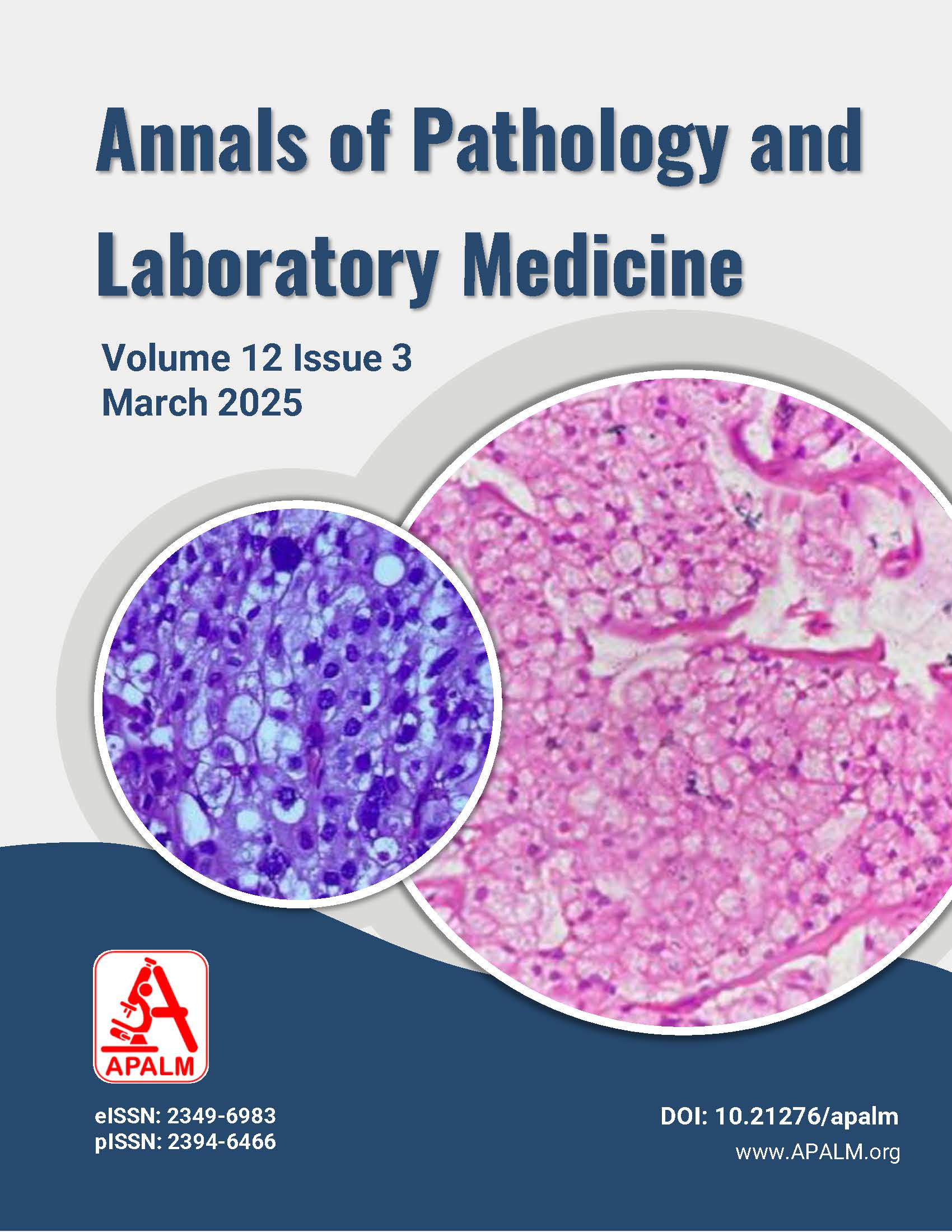Application of the Milan System for Reporting Salivary Gland Cytopathology: A Tertiary Care Experience
DOI:
https://doi.org/10.21276/apalm.3474Keywords:
The Milan system, Salivary Glands, Fine needle aspiration cytology, malignant.Abstract
Background: Fine-needle aspiration cytology (FNAC) of salivary gland lesions poses diagnostic challenges due to diverse features and overlapping characteristics. To address this, the Milan System for Reporting Salivary Gland Cytopathology (MSRSGC) was established to promote standardized reporting and improve clinico-pathologic correlation. The aim of the present study was to assess the application of the MSRSGC on FNAC specimens of salivary gland lesions at B.J. Medical College and Hospital.
Materials and Methods: A retrospective study was conducted, retrieving clinical information and cytology smear slides from salivary gland lesions diagnosed between January 2022 and July 2024. The cytological features were evaluated and the cases were classified according to the MSRSGC.
Results: A total of 118 cases were evaluated cytologically. The distribution of cases into different categories was as follows: Non-diagnostic (12.71%), Non-neoplastic (38.99%), Atypia of Undetermined Significance (5.08%), Neoplasm: Benign (33.05%), Salivary Gland Neoplasm of Uncertain Malignant Potential (3.39%), Suspicious for Malignancy (1.69%), and Malignancy (5.08%). The Risk of Malignancy (ROM) for non-diagnostic, non-neoplastic, benign neoplasms, AUS, SUMP, SFM, and malignant were 0%, 0%, 50%, 2.7%, 100%, 100%, and 100%, respectively.
Conclusion: The MSRSGC is an essential tool for standardizing reporting and preoperatively stratifying cases. The findings of this study reinforce the value of MSRSGC in enhancing diagnostic accuracy, stratifying malignancy risk, and facilitating collaborative patient management between cytopathologists and clinicians, highlighting the need for ongoing refinement and widespread adoption.
References
1. Naz S, Hashmi AA, Khurshid A, et al. Diagnostic role of fine needle aspiration cytology (FNAC) in the evaluation of salivary gland swelling: an institutional experience. BMC Res Notes. 2015;8:101.
2. Tochtermann G, Nowack M, Hagen C, Rupp NJ, Ikenberg K, Broglie MA, et al. The Milan system for reporting salivary gland cytopathology—a single-center study of 2156 cases. Cancer Med. 2023;12(11):12198–207.
3. Singh G, Jahan A, Yadav SK, Gupta R, Sarin N, Singh S. The Milan System for Reporting Salivary Gland Cytopathology: an outcome of retrospective application to three years' cytology data of a tertiary care hospital. Cytojournal. 2021;18:12.
4. Baloch Z, Lubin D, Katabi N, Wenig BM, Wojcik EM. Chapter 1. In: The Milan System for Reporting Salivary Gland Cytopathology. 2nd ed. Springer; 2023. p. 1–3.
5. Eneroth C, Frazén S, Zajicek J. Cytologic diagnosis on aspirate from 1000 salivary-gland tumours. Acta Otolaryngol Suppl. 1967;63(Suppl 224):168–72.
6. Mairembam P, Jay A, Beale T, Morley S, Vaz F, Kalavrezos N, et al. Salivary gland FNA cytology: role as a triage tool and an approach to pitfalls in cytomorphology. Cytopathology. 2016;27(2).
7. Kala C, Kala S, Khan L. Milan System for Reporting Salivary Gland Cytopathology: an experience with the implication for risk of malignancy. J Cytol. 2019;36(3):160–4.
8. Rohilla M, Singh P, Rajwanshi A, Gupta N, Srinivasan R, Dey P, et al. Three-year cytohistological correlation of salivary gland FNA cytology at a tertiary center with the application of the Milan system for risk stratification. Cancer Cytopathol. 2017;125(10).
9. Datta B, Daimary M, Bordoloi K, Thakuria C. Cytopathological spectrum of salivary gland lesions according to the Milan system for reporting salivary gland cytopathology: a retrospective study. Asian Pac J Cancer Care. 2023;8(3).
10. Jha S, Mitra S, Purkait S, Adhya AK. The Milan system for reporting salivary gland cytopathology: assessment of cytohistological concordance and risk of malignancy. Acta Cytol. 2021;65(1).
11. Karuna V, Gupta P, Rathi M, Grover K, Nigam JS, Verma N. Effectuation to cognize malignancy risk and accuracy of fine needle aspiration cytology in salivary gland using the "Milan System for Reporting Salivary Gland Cytopathology": a 2-year retrospective study in an academic institution. Indian J Pathol Microbiol. 2019;62(1).
12. Viswanathan K, Sung S, Scognamiglio T, Yang GCH, Siddiqui MT, Rao RA. The role of the Milan System for Reporting Salivary Gland Cytopathology: a 5-year institutional experience. Cancer Cytopathol. 2018;126(8):589–90.
13. Song SJ, Shafique K, Wong LQ, LiVolsi VA, Montone KT, Baloch Z. The utility of the Milan System as a risk stratification tool for salivary gland fine needle aspiration cytology specimens. Cytopathology. 2019;30(1).
14. Leite AA, Vargas PA, Dos Santos Silva AR, Galvis MM, Sá RS, Lopes Pinto CA, et al. Retrospective application of the Milan System for reporting salivary gland cytopathology: a cancer center experience. Diagn Cytopathol. 2020;48(9):788–94.
Downloads
Published
Issue
Section
License
Copyright (c) 2025 Jheel Sureshbhai Anjaria, Purvi Sharad Patel, Shital P. Vaghasiya, Dipal Kantibhai Hadavani, Sree Pooja Rajmohan , Hansa Goswami

This work is licensed under a Creative Commons Attribution 4.0 International License.
Authors who publish with this journal agree to the following terms:
- Authors retain copyright and grant the journal right of first publication with the work simultaneously licensed under a Creative Commons Attribution License that allows others to share the work with an acknowledgement of the work's authorship and initial publication in this journal.
- Authors are able to enter into separate, additional contractual arrangements for the non-exclusive distribution of the journal's published version of the work (e.g., post it to an institutional repository or publish it in a book), with an acknowledgement of its initial publication in this journal.
- Authors are permitted and encouraged to post their work online (e.g., in institutional repositories or on their website) prior to and during the submission process, as it can lead to productive exchanges, as well as earlier and greater citation of published work (See The Effect of Open Access at http://opcit.eprints.org/oacitation-biblio.html).










